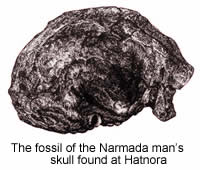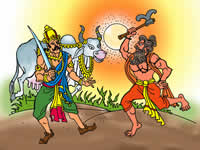
Dimdima
Online Children's Magazine from India

Dimdima
Online Children's Magazine from India

Some years ago, a part of a skull, 200,000 years old, was found near Hatnora on the left bank of the river Narmada. It was classified as a Homo Erectus fossil. The Homo Erectus is believed to be a forerunner of modern man. Later it was found that the Narmada fossil represented an individual who had a larger brain than the Homo Erectus. The fossil is now known as the Narmada Man. The Narmada Man lived in the river valley and in the Bhimbetka caves, 150 kilometres away.
The Bhimbetka caves are also home to the largest collection of prehistoric art in India. Over 600 natural rock shelters belonging to the Stone Age have been discovered here. The Pandavas spent some time of their exile in these parts, and Bhima is said to have lived in the caves. Recently the caves were included in UNESCO's list of World Heritage Sites.
Before leaving Hoshangabad for Nimawar, the Narmada is joined by Tawa, its longest tributary. The 172-km-long Tawa rises in the Mahadeo Hills in the Chindwara district, flows through Betul and joins the Narmada at Hoshangabad district.
Nimawar’s landmark is the Siddeshwar temple overlooking the river. The honey-coloured spires of the temple dominate the landscape. While the locals believe that it was built by the Pandavas in one night, in reality it was constructed by Raja Bhoja, a great scholar and aesthete, who ruled from Dhar near Mandu.
 According to legend, Rishi Jamadagini’s ashram was in this area. Once Kartivir Arjun, the Kalachuri King of Maheshwar, further down the river, was out hunting, when he stopped by to rest at the ashram. The sage was away with his five sons, but his wife Renuka took care of the king’s needs. During his stay at the ashram, the king’s eyes fell on Kamadhenu, the sage’s cow of bounty. Deciding that the cow was better off in the hands of a king rather than a hermit, he took the cow with him when he left. When the sage and his sons returned, they were furious. Jamadagini’s son, Parashurama, rushed to the Kalachuri kingdom and brought back the cow after killing Kartivir Arjun in a battle. In retaliation, the sons of Kartivir Arjun attacked the ashram when Parashuram was away and killed Jamadagini. The story goes that Parashuram in a rage, swore eternal vengeance against all Kshatriyas and fought 21 great battles against them.
According to legend, Rishi Jamadagini’s ashram was in this area. Once Kartivir Arjun, the Kalachuri King of Maheshwar, further down the river, was out hunting, when he stopped by to rest at the ashram. The sage was away with his five sons, but his wife Renuka took care of the king’s needs. During his stay at the ashram, the king’s eyes fell on Kamadhenu, the sage’s cow of bounty. Deciding that the cow was better off in the hands of a king rather than a hermit, he took the cow with him when he left. When the sage and his sons returned, they were furious. Jamadagini’s son, Parashurama, rushed to the Kalachuri kingdom and brought back the cow after killing Kartivir Arjun in a battle. In retaliation, the sons of Kartivir Arjun attacked the ashram when Parashuram was away and killed Jamadagini. The story goes that Parashuram in a rage, swore eternal vengeance against all Kshatriyas and fought 21 great battles against them.
Last updated on :12/5/2005
Dimdima is the Sanskrit word for ‘drumbeat’. In olden days, victory in battle was heralded by the beat of drums or any important news to be conveyed to the people used to be accompanied with drumbeats.
Bharatiya Vidya Bhavan
K. M Munshi Marg,
Chowpatty, Mumbai - 400 007
email : editor@dimdima.com
Bharatiya Vidya Bhavan
505, Sane Guruji Marg,
Tardeo, Mumbai - 400 034
email : promo@dimdima.com
Dimdima.com, the Children's Website of Bharatiya Vidya Bhavan launched in 2000 and came out with a Printed version of Dimdima Magazine in 2004. At present the Printed Version have more than 35,000 subscribers from India and Abroad.